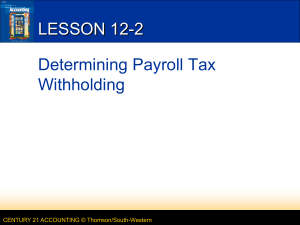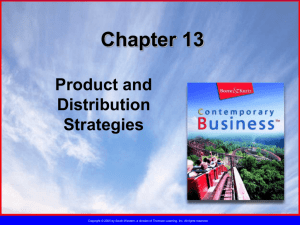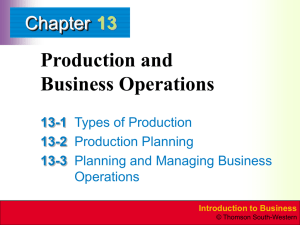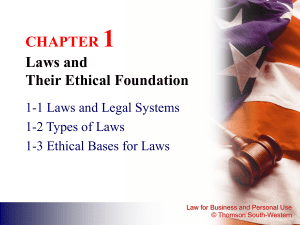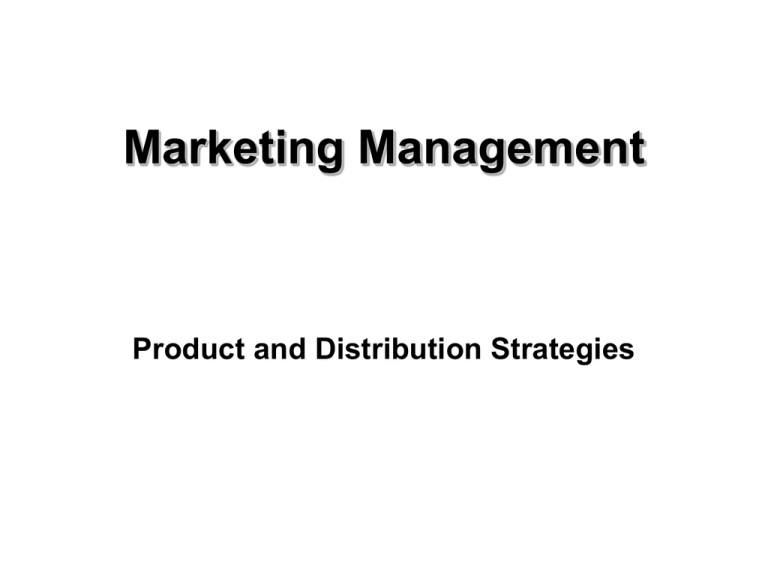
Marketing Management
Product and Distribution Strategies
1-1
Copyright © 2005 by South-Western, a division of Thomson Learning, Inc. All rights reserved.
Product Strategy
● Product—bundle of physical, service, and
symbolic attributes designed to enhance
buyers’ want satisfaction.
– Included in this broad definition are
considerations of package design, brand
names, warranties, and product image
1-2
Copyright © 2005 by South-Western, a division of Thomson Learning, Inc. All rights reserved.
● Marketing Impacts of Consumer Product
Classifications
1-3
Copyright © 2005 by South-Western, a division of Thomson Learning, Inc. All rights reserved.
Product Strategy
● Product Lines and Product Mix
– Product Line—group of related products
that are physically similar or are intended
for the same market.
– Product Mix—company’s assortment of
product lines and individual offerings.
– Examples of each?
1-4
Copyright © 2005 by South-Western, a division of Thomson Learning, Inc. All rights reserved.
Product Life Cycle – Know this!
● Product Life Cycle—four basic stages
through which a successful product
progresses.
– Introduction
– Growth
– Maturity
– Decline
1-5
Copyright © 2005 by South-Western, a division of Thomson Learning, Inc. All rights reserved.
Stages in the Product Life Cycle
Cash Cow
Note how things have changed since this chart was made.
1-6
Copyright © 2005 by South-Western, a division of Thomson Learning, Inc. All rights reserved.
● Marketing Strategy Implications of the
Product Life Cycle
1-7
Copyright © 2005 by South-Western, a division of Thomson Learning, Inc. All rights reserved.
Product Identification
● Brand—name, term sign, symbol, design, or
some combination that identifies the products
of a firm and distinguishes them from
competitive offerings.
● Brand name—the part of a brand consisting
of words or letters that form a name that
identifies and distinguishes an offering from
those of competitors
● Trademark—brand with legal protection
against another company’s use (can include
pictorial designs, slogans, packaging
elements, and product features)
● Examples? Oreo and TM licensing
1-8
Copyright © 2005 by South-Western, a division of Thomson Learning, Inc. All rights reserved.
Product Identification
● Brand Categories
– Manufacturer’s (or national) brands—
brand offered and promoted by a
manufacturer or producer
e.g. Ferrari
– Private (or store) brand—identifies a
product that is not linked to the
manufacturer, but instead carries the label
of a retailer or wholesaler
e.g. Kenmore, Jaclyn Smith, Berkeley &
Jensen, Nature’s Promise, …
– Generic
1-9
Copyright © 2005 by South-Western, a division of Thomson Learning, Inc. All rights reserved.
Brand Loyalty
● Brand Recognition—brand acceptance
strong enough that the consumer is aware of
a brand, but not enough to cause a
preference over competing brands
● Brand Preference—occurs when a
consumer chooses one firm’s brand, when it
is available, over a competitors
● Brand Insistence—when the consumer will
accept no substitute for a preferred brand
1-10
Copyright © 2005 by South-Western, a division of Thomson Learning, Inc. All rights reserved.
Brand Equity
● Added value that a certain brand name gives
to a product
● Added value means it is worth something
– i.e. you can charge more
1-11
Copyright © 2005 by South-Western, a division of Thomson Learning, Inc. All rights reserved.
Distribution Strategy
● Distribution Channels
– Distribution Channel—path through
which products - and legal ownership of
them - flow from producer to consumers or
business users.
– Physical Distribution—actual movement
of products from producer to consumer or
business users.
1-12
Copyright © 2005 by South-Western, a division of Thomson Learning, Inc. All rights reserved.
● Alternative Distribution Channels
1-13
Copyright © 2005 by South-Western, a division of Thomson Learning, Inc. All rights reserved.
Distribution Channels
● Different channels for the same product may
compete with each other
– “Channel conflict”
● How do manufacturers try to minimize
channel conflict?
1-14
Copyright © 2005 by South-Western, a division of Thomson Learning, Inc. All rights reserved.
Distribution Channel Decisions and
Physical Distribution
● Logistics and Physical Distribution
– Warehousing—storing products as they
move through the distribution channel
Storage warehouses
Distribution warehouses
– Materials Handling
– Order Processing (Fulfillment)
– Vendor-Managed Inventory
1-15
Copyright © 2005 by South-Western, a division of Thomson Learning, Inc. All rights reserved.
Discussion
● Select a retailer
– what is good and bad about the store?
– how does the retailer differentiate itself?
● Select a product (Coke, Ferrari, textbooks)
– what is the distribution chain?
– why does the distribution mechanism fit the
type of product?
● Assume we develop a great new cookie
– what would we do at each stage of product
development?
– how would we distribute it?
1-16
Copyright © 2005 by South-Western, a division of Thomson Learning, Inc. All rights reserved.







